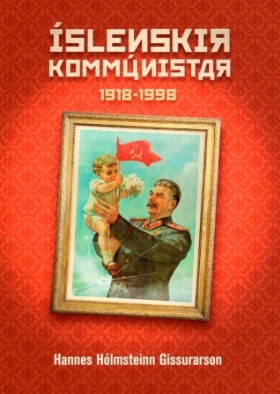
Cartoon by Halldor Petursson of the three different incarnations of the radical left movement in Iceland.
RNH Academic Director Hannes H. Gissurarson, Professor of Politics at the University of Iceland, read a paper at a conference organised by the Icelandic Association of Political Scientists 16 June 2016. The paper was on why the Icelandic Left was smaller and more radical than in the Scandinavian countries. (By the Left Professor Gissurarson meant the combined electoral support support of social democrats and communists: In Iceland, they traditionally constituted about one-third of the voters, but about one-half in Sweden, Denmark and Norway.) A plausible explanation why the Left was small in Iceland was, Professor Gissurarson contended, that in the formative years of party politics Iceland was not as industrialised and urbanised as the Scandinavian countries, while the still vivid legacy from the independence struggle also hampered the Icelandic Left.
But why was the Icelandic Left so radical? Why did communists or left socialists in the early 1940s surpass the social democrats in the race for votes? An answer often given is that their leaders, Brynjolfur Bjarnason and Einar Olgeirsson, were astute politicians. But Professor Gissurarson commented that it was by no means evident that they were any abler than the social democratic leaders, Jon Baldvinsson, Haraldur Gudmundsson, and Stefan Johann Stefansson.
Professor Gissurarson suggested that probably the Socialist Unity Party in Iceland, formed in 1938 and dominated by communists, was more akin to the Finnish People’s Democratic League, formed in 1944 and also dominated by communists, than to the Scandinavian communist parties, for three reasons. First, Finland and Iceland had in early 20th century been much poorer than the three Scandinavian countries. Second, they had both been new states, Finland declaring her independence in 1917 and Iceland becoming a sovereign state in 1918. Third, civil society, with its invisible institutions, customs and traditions, had been less developed there than in the three Scandinavian countries, and therefore the ground had been more fertile to the seeds of revolution. Both the Icelandic Socialist Unity Party and the Finnish People’s Democratic League had electoral support of around 15–20% in the 1940s and 1950s.
 Professor Gissurarson also pointed out that the Icelandic left socialists had enjoyed significant financial support from Moscow and that Icelandic voters, living in a very peaceful country, had been, and still are, somewhat naive, not taking the revolutionary rhetoric of the communists seriously. It was however clear, he said, that the Icelandic communist party of 1930–1938, and the Socialist Unity Party of 1938–1968 were both controlled by hardcore stalinists. Their supporters often resorted to street violence to further their aims, and the leaders had a close relationship with Moscow. On this, Professor Gissurarson referred to his book on the Icelandic communist movement. The People’s Alliance, an electoral alliance in 1956–1968 in which the Socialist Unity Party participated, and a political party after that, was more ambivalent about world communism. It did not have any official ties with Soviet communists, while it cultivated some other communist parties: For example, the last act of the party was to accept an invitation to send a delegation in 1998 to the Cuban communist party.
Professor Gissurarson also pointed out that the Icelandic left socialists had enjoyed significant financial support from Moscow and that Icelandic voters, living in a very peaceful country, had been, and still are, somewhat naive, not taking the revolutionary rhetoric of the communists seriously. It was however clear, he said, that the Icelandic communist party of 1930–1938, and the Socialist Unity Party of 1938–1968 were both controlled by hardcore stalinists. Their supporters often resorted to street violence to further their aims, and the leaders had a close relationship with Moscow. On this, Professor Gissurarson referred to his book on the Icelandic communist movement. The People’s Alliance, an electoral alliance in 1956–1968 in which the Socialist Unity Party participated, and a political party after that, was more ambivalent about world communism. It did not have any official ties with Soviet communists, while it cultivated some other communist parties: For example, the last act of the party was to accept an invitation to send a delegation in 1998 to the Cuban communist party.
 Professor Gissurarson’s lecture formed a part of the joint project by RNH and AECR on “Europe of the Victims”, where the goal is not to forget the words and deeds, or misdeeds, of communists and other 20th century totalitarians. Professor Gissurarson is the editor of a series of historical works on the struggle in Iceland against totalitarian communism. The books already published include articles on communism (Greinar um kommunisma) by Bertrand Russell, memoirs of Stalin’s prison camps (Konur i thraelakistum Stalins) by Elinor Lipper and Aino Kuusinen, and Out of the Night (Ur alogum) by Jan Valtin (Richard Krebs).
Professor Gissurarson’s lecture formed a part of the joint project by RNH and AECR on “Europe of the Victims”, where the goal is not to forget the words and deeds, or misdeeds, of communists and other 20th century totalitarians. Professor Gissurarson is the editor of a series of historical works on the struggle in Iceland against totalitarian communism. The books already published include articles on communism (Greinar um kommunisma) by Bertrand Russell, memoirs of Stalin’s prison camps (Konur i thraelakistum Stalins) by Elinor Lipper and Aino Kuusinen, and Out of the Night (Ur alogum) by Jan Valtin (Richard Krebs).


